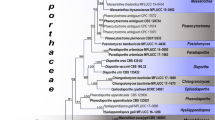Abstract
A new Terriera species, T. elliptica on twigs of Rhododendron sp., was reported from Yunnan Province, China. T. elliptica is similar to Lophodermium camelliicola in morphology and affiliation, but differs in having elliptic, non-curved ascomata and larger asci. In addition, ITS rDNA sequences of the two species differ significantly. Based on morphological and molecular analyses, L. camelliicola was transferred to Terriera.



Similar content being viewed by others
References
Chen JL, Lin YR, Hou CL, Wang SJ (2011) Species of Rhytismataceae on Camellia spp. from the Chinese mainland. Mycotaxon 118:219–230. doi:10.5248/118.219
Chen L, Minter DW, Wang SJ, Lin YR (2013) Two new species of Rhytismataceae on fagaceous trees. Mycotaxon 126:109–120. doi:10.5248/126.109
Eriksson B (1970) On Ascomycetes on Diapensales and Ericales in Fennoscandia. 1. Discomycetes. Symb Bot Upsal 19(4):1–71
Farris JS, Kallersjø M, Kluge AG, Bult C (1995) Testing significance of incongruence. Cladistics 10:315–319. doi:10.1111/j.1096-0031.1994.tb00181.x
Gao XM, Zheng CT, Lin YR (2012) Terriera simplex, a new species of Rhytismatales from China. Mycotaxon 120:209–213. doi:10.5248/120.209
Gardes M, Bruns TD (1993) ITS primers with enhanced specificity for basidiomycetes application to the identification of mycorrhizae and rusts. Mol Ecol 2:113–118. doi:10.1111/j.1365-294X.1993.tb00005.x
Hou CL, Li L, Piepenbring M (2009) Lophodermium pini-mugonis sp. nov. on needles of Pinus mugo from the Alps based on morphological and molecular data. Mycol Prog 8:29–33. doi:10.1007/s11557-008-0575-z
Huelsenbeck JP, Bull JJ, Cunningham CW (1996) Combining data in phylogenetic analysis. TREE 11:152–158. doi: 10.1016/0169-5347(96)10006-9
Huelsenbeck JP, Ronquist F, Nielsen R, Bollback JP (2001) Bayesian inference of phylogeny and its impact on evolutionary biology. Science 294:2310–2314. doi:10.1126/science.1065889
Johnston PR (1988) An undescribed pattern of ascocarp development in some non-coniferous Lophodermium species. Mycotaxon 31:383–394
Johnston PR (1989) Lophodermium (Rhytismataceae) on Clusia. Sydowia 41:170–179
Johnston PR (2001) Monograph of the monocotyledon-inhabiting species of Lophodermium. Mycol Pap 176:1–239
Kirk PM, Cannon PF, Minter DW, Stalpers JA (2008) Dictionary of the fungi, 10th edn. CAB International, Wallingford, p 771
Lantz H, Johnston PR, Park D, Minter DW (2011) Molecular phylogeny reveals a core clade of Rhytismatales. Mycologia 103:57–74. doi:10.3852/10-060
Lin YR, Liu HY, Hou CL, Wang SJ, Ye M, Huang CL, Xiang Y, Yu SM (2012) Flora Fungorum Sinicorum, Vol. 40, Rhytismatales. Science Press. Beijing. pp 1–261
Minter DW (1996) Terriera cladophila. IMI Descr. Fungi & Bact. no. 1296
Minter DW, Sharma MP (1982) Three species of Lophodermium from the Himalayas. Mycologia 74:702–711. doi:10.2307/3792855
Nylander JAA (2004) MrModeltest v2. Program distributed by the author. Uppsala, Sweden: Evolutionary Biology Centre, Uppsala Univ.
Rambaut A (2000) Estimating the rate of molecular evolution: incorporating non-contemp oraneous sequences into maximum likelihood phylogenies. Bioinformatics 16:395–399. doi:10.1093/bioinformatics/16.4.395
Ronquist F, Huelsenbeck JP (2003) MrBayes 3: Bayesian Phylogenetic inference under mixed models. Bioinformatics 19:1572–1574. doi:10.1093/bioinformatics/btg180
Song JF, Liu L, Li YY, Hou CL (2012) Two new species of Terriera from Yunnan Province, China. Mycotaxon 119:329–335. doi:10.5248/119.329
Swofford DL (1998) PAUP*: phylogenetic analysis using parsimony (and other methods). Version 4. Sunderland, Massachusetts: Sinauer Associates
Thompson JD, Gibson TJ, Plewniak F, Jeanmougin F, Higgins DG (1997) The ClustalX windows interface: flexible strategies for multiple sequence alignment aided by quality analysis tools. Nucleic Acids Res 24:4876–4882. doi:10.1093/nar/ 25.24.4876
Wang S, Kirschner R, Wang YW, Hou CL (2014) Hypohelion from China. Mycol Prog 13:781–789. doi:10.1007/s11557-014-0961-7
White TJ, Bruns T, Lee S, Taylor J (1990) Amplification and direct sequencing of fungal ribosomal RNA genes for phylogenetics. In: Innis MA, Gelfand DH, Sninsky JJ, White TJ (eds) PCR protocols: a guide to methods and applications. Academic, New York, pp 315–322
Yang ZZ, Lin YR, Hou CL (2011) A new species of Terriera (Rhytismatales, Ascomycota) from China. Mycotaxon 117:367–371. doi:10.5248/117.367
Zheng Q, Lin YR, Yu SM, Chen L (2011) Species of Rhytismataceae on Lithocarpus spp. from Mt Huangshan, China. Mycotaxon 118:311–323. doi:10.5248/118.311
Zhou F, Wang XY, Zhang L, Lin YR (2012) Terriera angularis sp. nov. from Illicium simonsii from China. Mycotaxon 122:355–359. doi:10.5248/122.355
Zoller S, Scheidegger C, Sperisen C (1999) PCR primers for the amplification of mitochondrial small subunit ribosomal DNA of lichen-forming ascomycetes. Lichenologist 31:511–516. doi:10.1006/lich.1999.0220
Acknowledgments
This study was supported by Beijing Natural Science Foundation (No. 5132009) and the National Natural Science Foundation of China (No. 31170019 and 31270065).
Author information
Authors and Affiliations
Corresponding author
Rights and permissions
About this article
Cite this article
Zhang, TT., Tong, X., Lin, YR. et al. A new species and a new combination of Terriera based on morphological and molecular data. Mycol Progress 14, 54 (2015). https://doi.org/10.1007/s11557-015-1078-3
Received:
Revised:
Accepted:
Published:
DOI: https://doi.org/10.1007/s11557-015-1078-3




